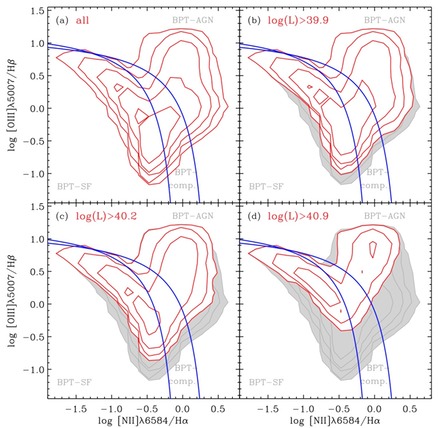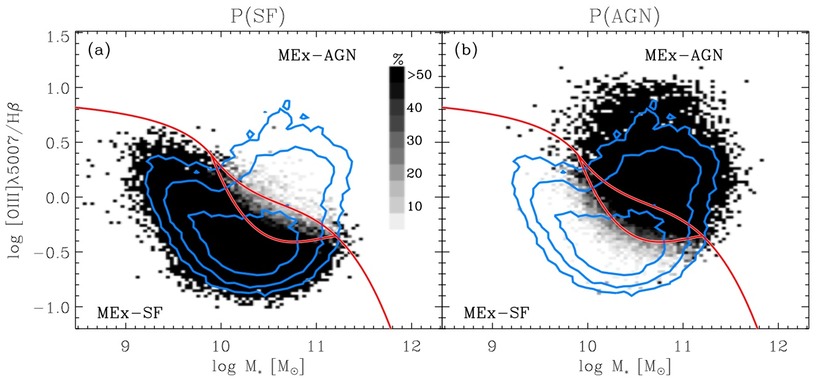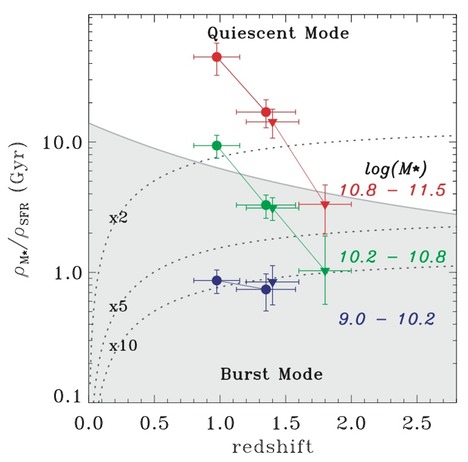My research interests focus on galaxy evolution. I am especially intrigued by the way galaxies formed and assembled their stars as well as by the interplay between star formation and active accretion around super-massive black holes at the center of galaxies — or Active Galactic Nuclei (AGNs).
My publication list can be found from ADS here, and research highlights are included below. I am also developing and maintaining a separate website hosting a compilation of AGN diagnostic methods (including the Mass-Excitation diagnostic diagram), which can be found here.
Ionized Gas Conditions in Galaxies: Selection Effects and Evolution

In the past, galaxies may have been forming their stars differently or may have had different gas properties. Perhaps the gas was denser, more highly pressurized, more strongly ionized by luminous young stars and/or active nuclei. However, our current studies of distant galaxies are often limited to the brightest galaxies because we cannot detect the fainter systems. Thus, it is possible that our view of distant galaxies is biased. To gain a better understanding, we simultaneously addressed the questions of selection effects (due to detection limits) and evolution in the gas content of galaxies. We demonstrated that selection effects may mimic or exaggerate true evolutionary trends in the gas properties of galaxies, and we described recipes to account for selection effects in order to get a handle on residual cosmic evolution. Our recipes naturally reproduce the shift in chemical abundance observed in star-forming galaxies (the Stellar Mass-Metallicity relation). Furthermore, we found hints for a lower metal content in the gas illumated by active black holes (narrow-line regions) in distant galaxies, in the sense that regions around the black hole were less enriched in the past, as also suggested by other teams. This work is published in the Astrophysical Journal (Juneau et al. 2014, ApJ 788, 88; arXiv1403.6832).
Obscured Active Nuclei in Star-Forming Galaxies
We found a strong tendency for galaxies that host highly-obscured AGNs at X-ray wavelengths to be infrared-luminous (significantly forming new stars). This result implies that some of the obscuration likely comes from the material in the host galaxies, i.e., beyond the torus invoked in traditional AGN unified models, and could therefore result in a paradigm shift regarding the main mode of obscuration of AGNs. This may be especially relevant at high redshifts, where galaxies were on average more actively forming stars. For details, see Juneau et al. 2013, ApJ 764, 176 (arXiv1211.6436).
New Optical Diagnostic of AGNs: Revealing a Population of Obscured Systems

We developed a new optical diagnostic diagram to identify galaxies that host active galactic nuclei out to z<1 with optical spectra (and z<3.5 with near-infrared K-band spectra). The diagnostic is calibrated with SDSS galaxies against traditional nebular line diagnostics (BPT, VO87 diagrams), and shows an excellent agreement with an independant X-ray classification scheme. Using a probabilistic apporach allows us to identify sources that are missed or misclassified in the X-rays due to being too weak or too obscured. These two populations of AGNs are challenging to identify because their signatures are often diluted with star formation. Indeed, we find that most of the heavily-obscured AGNs reside in so-called composite galaxies, which host both star formation and AGN. The most obscured AGNs are candidate Compton-Thick AGNs. Our findings are published in the Astrophysical Journal (Juneau et al. 2011, ApJ 736, 104; arXiv1105.3194)
The probabilistic classification scheme was revised in 2014, and is available on this website.
Enhanced Dense Gas Fraction in Ultra-Luminous Infrared Galaxies
Using a combination of five molecular line transitions, we probe the density profile of molecular gas in nearby luminous infrared galaxies (LIRGs, L(IR)>10^11 Lsun) and ultraluminous infrared galaxies (ULIRGs, L(IR)>10^12 Lsun). We find that the enhanced line ratios hint for a higher dense gas fraction in these systems, in agreement with the original interpretation by Gao et al. but in contrast with other interpretations invoking AGN-induced chemistry effects. Overall, the trends support a picture where gas-rich mergers both cause a higher dense gas fraction and trigger AGN phases (accretion onto supermassive black holes). This study is published in the Astrophysical Journal (Juneau et al. 2009, ApJ 707, 1217; arXiv0911.0413).
Cosmic Star Formation History and its Dependence on Stellar Mass

With members of the Gemini Deep Deep Survey (GDDS), I conducted a project on the cosmic star formation history since redshift z=2, when the Universe was about 1/3 of its current age. We found a strong dependence of the rate of decline of star formation on galaxy stellar mass. Our main results imply that the most massive galaxies formed their stellar content earlier than their lower-mass counterparts, which form stars actively until later cosmic times. This phenomenon, originally termed downsizing by Cowie et al (1996), is now widely accepted for the bulk of the galaxy population, although it was subject to important conflicts with early hierarchical models of galaxy evolution. We presented the first strong observational evidence for downsizing, which was since confirmed by several other studies (e.g., Papovich et al 2006). This work is published in a Letter to the Astrophysical Journal (Juneau et al. 2005, ApJ 619, L135; arXiv0411775).